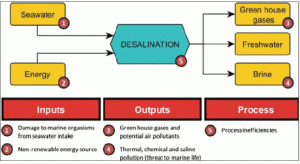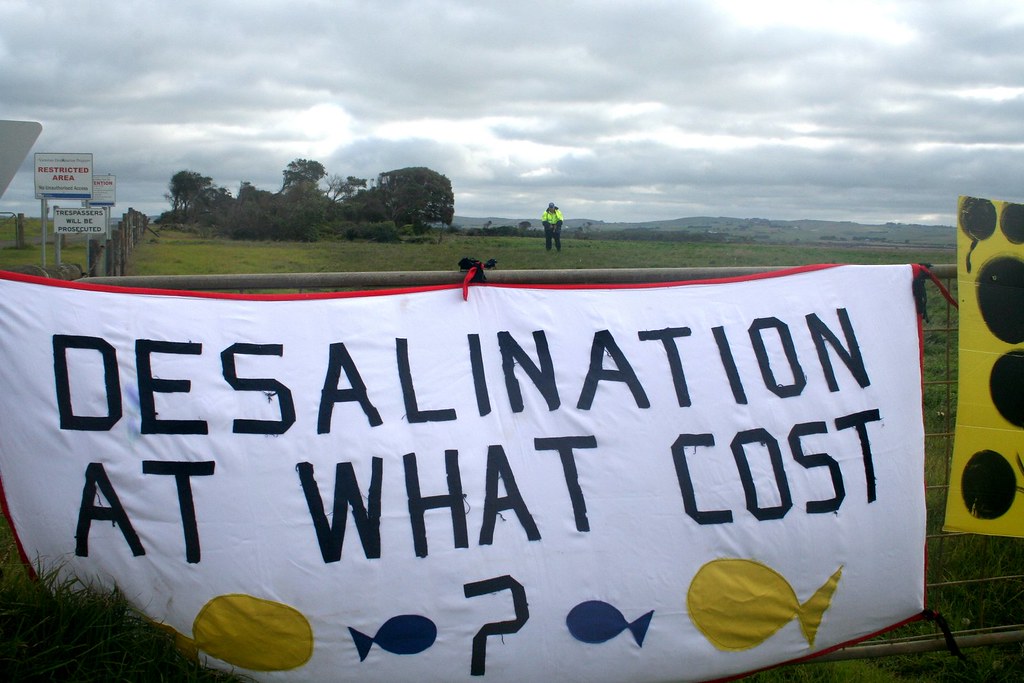The arid Chilean Atacama Desert is home to more than a million people living in one of the driest places on Earth (Figure 1), and in the face of increasing heat from climate change, an expanding mining industry that is expected to build as many as 15 new desalination plants by 2028. Despite increasingly scarce water supplies in the region, this expansion of desalination may also be leading to significant longer-term environmental challenges, including groundwater pollution, damage to vital infrastructure, and the destruction of wetland pastures that are critical to indigenous cultural practices.1

The northern region of Chile is inhabited by the Atacameño and Aymara indigenous communities (Figure 2), who, along with native wildlife, are in continuous competition for water resources with mining and other human activities. As a result of the Water Code designed by General Pinochet’s dictatorship in 1981, Chile has a free market for the utilization of water. This free market, however, has contributed to water scarcity by promoting mining in the area through the free buying, selling, and mortgaging of water rights.3
Chile is a major producer of copper, molybdenum, lithium, and natural nitrates. The most productive mining regions are in northern Chile, in the cities of Antofagasta and Atacama, where there are 18 combined desalination plants.9 To protect water supplies, national legislation requires the development of desalination plants at all mining sites in Chile. Two regulatory assessments that are required to be published in the Environmental Impact Evaluation System (SEIA) are the Environment Impact Assessment (EIAs) and Declaration of Environmental Impact (DIAs). These regulatory assessments are developed to identify possible hazardous environment impacts such as pollution and environmental hazards related to future developed desalination projects. Numerous studies, however, have shown that the EIA/DIA process as implemented only provides limited consideration of social impacts that can account for a wide scope of environmental impacts.10 In addition, many impact assessments are limited and/or provide irrelevant descriptors for various environmental impacts, such as impacts of brine discharges into marine ecosystems, and high energy demand for desalination. This lack of social and environmental consideration presents challenges among indigenous communities and ecosystems, and can produce uncertainty in assessing future environmental impacts associated with planned desalination plants.11 If environmental impacts are not rigorously evaluated, mining companies and desalination projects can result in damage to groundwater aquifers that are relied on for agricultural and other daily use, as well as the cultural practices of nearby indigenous communities. Many towns in the region have proposed local monitors from the community to manage water sources, rather than receiving professional assistance that is imposed on their communities. This distrust stems from the perceived failures of earlier legislation, such as the Indigenous Law in 1993, that was intended to protect leftover water and territorial rights.12
In spite of legislation that has been implemented to regulate mining projects, it is evident that the Water Code of 1981 and mining regulations have been more effective at promoting the development of new infrastructure and the extraction of water in undeveloped pastoral areas. One example from the 1980s is the mining company MEL extracting water that supported a breeding ground for native Andean flamingos, ultimately resulting in the drying out of the lagoon. Mining companies and the associated desalination projects have also been shown to be the main activity in these areas causing disturbance to irrigation system that support agricultural rituals and daily practices of the indigenous communities. Studies have shown additional health issues resulting from water pollution, such as arsenic-induced lesions through years of exposure to contaminated water.13 One positive development seems to be the daily inspections performed by a selected individuals from the community whose job is to ensure the appropriate management of potential waste before opening channels that supply water for irrigation and plumbing.14 Additional environmental impacts (Figure 3) include the disturbance of ocean floor sediments in the desalination process from machinery, and the disposal of associated harmful chemicals, and emissions produced due to a lack of accurate accounting for the energy and power required to desalinate and transport these waters.15

Despite the passage of this legislation, another mining project near an Atacameño village was proposed, including the construction of wells, pipelines, and hydroelectric plants, causing disturbance to native territories. The Indigenous Law of 1993 and other previous legislation appeared to be overpowered by the promotion of profit-seeking sectors of the economy. However, the conflict over water resources resulted in street rallies against the project by the Consejo de Pueblos Atacameño that ultimately led to the termination of the approval process for the project.
Through the last century, environmental impacts have not been sufficiently researched and characterized in the Atacama Desert, often resulting in damage to critical wildlife habitats, and the scarce water resources that are vital to indigenous communities. Failures in politics and the commodification of water has jeopardized water security, and neglected the needs of a threatened population and their traditional practices. Activism is the current solution, and offers hope for these marginalized Chilean communities. This activism is accompanied by encouragement to vote for representation that will prioritize changes to water legislation that considers the needs of indigenous communities over the economic focus of current water policies. With the continuous growth of desalination, an improvement in social and environmental legislation is critical to sustain these endangered populations.
- Babidge, Sally, “Contested value and an ethics of resources: Water, mining and indigenous people in the Atacama Desert, Chile”, The Australian Journal of Anthropology 27, 2016: 84–103, doi:10.1111/taja.12139 ↵
- Philipe,Thulio. Photograph. Unsplash. October 1, 2020. https://unsplash.com/photos/vDd7ogv5c1g ↵
- Hidalgo, Juan Pablo, Rutgerd Boelens, Jeroen Vos, “De-colonizing water. Dispossession, water insecurity, and Indigenous claims for resources, authority, and territory”, Springer Water History, 2017: 9:67–85, doi:10.1007/s12685-016-0186-6 ↵
- Pueblos Indigenas de Chile. Photograph.Wikimedia Commons. October 15, 2013.https://commons.wikimedia.org/wiki/File:Pueblos_indigenas_de_Chile-ver.svg ↵
- Herrera-León, Sebastián et al., “Current situation and major challenges of desalination in Chile”, Desalination and Water Treatment 171, 2019: 93–104, doi: 10.5004/dwt.2019.24863 ↵
- Sola, Iván, José L. Sánchez-Lizaso, Pamela T.Muñoz, Enzo García-Bartolomei, Claudio A. Sáez, and Domingo Zarzo, “Assessment of the Requirements within the Environmental Monitoring Plans Used to Evaluate the Environmental Impacts of Desalination Plants in Chile”, Water 11, no. 10(2019): 2085. https://doi.org/10.3390/w11102085 ↵
- Herrera-León, Sebastián et al., “Current situation and major challenges of desalination in Chile”, Desalination and Water Treatment 171, 2019: 93–104, doi:10.5004/dwt.2019.24863 ↵
- Babidge,Sally, “Contested value and an ethics of resources: Water, mining and indigenous people in the Atacama Desert, Chile”, The Australian Journal of Anthropology 27, 2016: 84–103, doi:10.1111/taja.12139 ↵
- Herrera-León, Sebastián et al., “Current situation and major challenges of desalination in Chile”, Desalination and Water Treatment 171, 2019: 93–104, doi:10.5004/dwt.2019.24863 ↵
- Cecilia Campero et al., “De-politicising seawater desalination: Environmental Impact Assessments in the Atacama mining Region, Chile”, Elsevier 120, 2021:187-194.https://doi.org/10.1016/j.envsci.2021.03.004 ↵
- Sola, Iván, José L. Sánchez-Lizaso, Pamela T. Muñoz, Enzo García-Bartolomei, Claudio A. Sáez, and Domingo Zarzo, “Assessment of the Requirements within the Environmental Monitoring Plans Used to Evaluate the Environmental Impacts of Desalination Plants in Chile”, Water 11, no. 10(2019): 2085. https://doi.org/10.3390/w11102085 ↵
- Babidge, Sally, “Contested value and an ethics of resources: Water, mining and indigenous people in the Atacama Desert, Chile”, The Australian Journal of Anthropology 27, 2016: 84–103, doi:10.1111/taja.12139 ↵
- Allan H. Smith et al.,”Arsenic-Induced Skin Lesions among Atacameño People in Northern Chile Despite Good Nutrition and Centuries of Exposure”, Environmental Health Perspectives 108, 7(2000): 617-620 ↵
- Babidge,Sally, “Contested value and an ethics of resources: Water, mining and indigenous people in the Atacama Desert, Chile”, The Australian Journal of Anthropology 27, 2016: 84–103, doi:10.1111/taja.12139 ↵
- Herrera-León, Sebastián et al., “Current situation and major challenges of desalination in Chile”, Desalination and Water Treatment 171, 2019: 93–104, doi: 10.5004/dwt.2019.24863 ↵
- Haya S Alyasi et al.: GHG emissions from desalination plant. Photograph. Sci Forsheschen. June 29, 2018.https://www.sciforschenonline.org/journals/environmental-toxicological-studies/JETS-2-114.php ↵
- Babidge, Sally, “Contested value and an ethics of resources: Water, mining and indigenous people in the Atacama Desert, Chile”, The Australian Journal of Anthropology 27, 2016: 84–103, doi:10.1111/taja.12139 ↵
- Hidalgo, Juan Pablo, Rutgerd Boelens, Jeroen Vos, “De-colonizing water. Dispossession, water insecurity, and Indigenous claims for resources, authority, and territory”, Springer Water History, 2017: 9:67–85, doi:10.1007/s12685-016-0186-6 ↵


13 comments
Sebastian Hernandez-Soihit
Great job exploring the potential benefits and drawbacks of this technology. Very well-cited analysis of the economic, environmental, and social factors that must be considered when evaluating the feasibility of seawater desalination as a way to move forward and avail accessibility.
Juan Aguirre Ramirez
Gina, your article was on point and very detailed. The government’s mistreatment of native lands in Chile is a topic that needs to be discussed more. It’s not just a problem in the US with pipelines destroying water and native lands, but it’s also happening in Chile. It’s heartbreaking to see that greed and money are valued more than the land that provides for people. These damages are irreversible and the native people and animals are left to suffer. It’s important to respect their culture and provide them with the resources they need to thrive. The article provides a solution that may not be perfect, but it’s a step in the right direction. It’s vital to understand the impact of our actions on the environment and the people and animals that depend on it.
Olivia Flores
I had no idea that Chile was struggling so bad with their water system. It is not surprising to see that the government is not protecting the people as well as they should as I feel that the people here have become neglected for some time now. The poor animals that are also suffering with this is so sad. Thank you for bringing awareness to this topic and writing such an informative article on the matter.
Amy Hotema
The harm the Chilean government does to indigenous lands was well-explained in this essay. Pipelines that damage water and native land are approved by the government in the US. These issues shouldn’t exist, yet individuals choose money and selfishness over the land that provides for their needs and the needs of others. These damages are irreparable, and even if they were, the results would not be the same. Because they are being abandoned, the native animals and people need to be treated with more respect. These performances must endure longer. They shouldn’t have to object to the promises made to them.
Robert Miller
It seems that with the shortage of water all over the world there would be effective ways to desalinate ocean water so that the resulting concerns could be better mitigated. Maybe some combination of reverse osmosis and desalination could provide better results. I am always hearing on the news about how the Colorado River is drying up and the surrounding states that use it as a water source are fighting over who gets what share of it. Great interesting article!
Courtney Mcclellan
This article is very informative and upsetting at the same time. It is terrible that the nations indigenous people are not able to practice their culture properly without water but the desalination plants are harming the indigenous wildlife and environment. It seems like every solution they look for has another issue that needs something else to solve. It was really nice to see the problem and solution point of view from the author.
Dylan Vargas
This type of topic doesn’t appeal to much, but I like how the article lays out the problem and shows while that Chile has tried to solve the problem. One that really struck out to me was the Desalination, now I know that its not healthy for the environment but I like how smart the idea was to change the salt water to regular water was smart. One thing that I also liked was how it told us how difficult it was for water to be distributed. For instance the miners and the mines in Chile are difficult cause they need that water and Chile is also a major producer of copper, molybdenum, lithium, and natural nitrates so they need that water. I like how the article and the author highlights that and gives a reason for the miners to be there in the first place.
Sara Davila
I really enjoyed this article and how it was able to bring a new perspective to the water shortages. If there is any method to improve water quality I am here for it. It is amazing how much the sciences can better our society and bring new solutions to world problems. I also enjoyed all the images that were in this article. It was able to give a imagine to the crisis and highlight the importance of what is happening.
Andrew Ponce
This article is very engaging to the reader with various images to look at for visual aid and the author even mentions the figures in the writing for the audience to take notice. An article covering topics like this are very interesting to come across, considering that most people do not even know what desalination is, even less the potential damage is has on the environment. Great job, well written!
Carlos Hinojosa
If us humans could solve and find a better way to desalt seawater, we would never have a water problem ever again. That’s why I always liked science since things like this are always attempted to be made. Honestly, I’ve seen some news about some pretty cool inventions, and I hope to see them one day change our world for the better. A very well-made article good job.